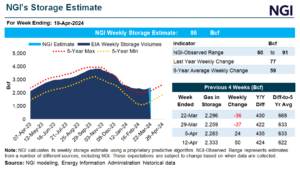Potential Triple-Digit EIA Build Weighs on Natural Gas Futures Early
Extending the previous session’s losses, natural gas futures were down several cents in early trading Thursday as the market prepared for the release of government storage data expected to show a plump triple-digit injection. The July Nymex contract was down 4.1 cents to $1.556/MMBtu at around 8:45 a.m. ET.

Estimates have the U.S. Energy Information Administration (EIA) reporting a hefty triple-digit injection in the latest weekly storage report at 10:30 a.m. ET. A Bloomberg poll found injection estimates ranging from 100 Bcf to 114 Bcf, with a median of 108 Bcf. A Wall Street Journal survey produced an average build expectation of 105 Bcf, while a Reuters survey of 17 analysts produced a 90 Bcf to 115 Bcf injection range and a median 106 Bcf injection. NGI estimated a 116 Bcf build for the report, which covers the week ended June 19.
The bearish expectations compare with a build of 103 Bcf during the same week a year earlier and the five-year average build of 73 Bcf for that week.
“It was cooler than normal over the western and eastern U.S. and hotter than normal over the central U.S.” during this week’s EIA report period, NatGasWeather said. “Our algorithm predicts a build of 111-112 Bcf.”
Analysts at EBW Analytics Group attributed the selling late in Wednesday’s session to “positioning by traders betting that EIA will release a bearish storage report this morning.
“With July options expiring at the end of today’s session, volatility could be high today,” the EBW analysts said. If estimates for a build in the neighborhood of 115-116 Bcf prove accurate, “the July contract could test support as low as $1.51-1.54. A build near or below the survey range, though, could send prices back up to the mid- to upper $1.60s.”
As for the overnight weather data, NatGasWeather said the latest guidance came in slightly hotter for early next week but somewhat cooler for the Fourth of July weekend.
“The data still favors a very warm U.S. pattern the next 15 days, just not exceptionally hot due to weak weather systems consistently finding flaws in the upper ridge to prevent extreme heat,” the forecaster said. “To our view, the onus is squarely on hot weather coming through this summer, and every time it doesn’t, it could lead to disappointment, especially due to hefty surpluses.”
Meanwhile, on the exports front, U.S. liquefied natural gas (LNG) feed gas demand could “get a little extra scrutiny” heading into next week as “higher reported cancellations” could see the month of July start off with further declines in feed gas volumes, according to Tudor, Pickering, Holt & Co. (TPH) analysts.
“Industry scuttlebutt pegged June cargo cancellations in the 30-35 range, with July weaker at a speculated 40-45 cancellations,” the TPH team said. “Cargoes can still be cancelled after the window closes (for an incremental fee) and producers can meet delivery obligations by sourcing cargoes from the market, so reported cancellations don’t tell the entire story, but directionally July is shaping up to be weaker than June.
“We’re currently modeling 3.7 Bcf/d of feed gas demand for July, down from a June average of 4.0 Bcf/d, and we don’t expect a meaningful recovery until September.”
August crude oil futures were down 80 cents to $37.21/bbl at around 8:45 a.m. ET, while July RBOB gasoline was down about 5.6 cents to $1.1402/gal.
© 2024 Natural Gas Intelligence. All rights reserved.
ISSN © 1532-1231 | ISSN © 2577-9877 |


